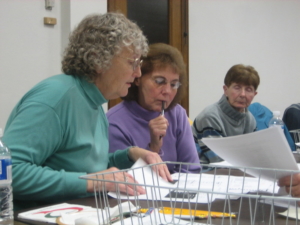
Election Resolution Judges
(h/t Lance Fisher and used under Attribution-ShareAlike 2.0 Generic [CC BY-SA 2.0])
Back in the day, when dinosaurs roamed the earth and all elections were conducted either with paper ballots or “pull the lever” machines, my high school government class was given an election season project. For the precinct around our high school, we were to do four things: (1) canvas the neighborhood to determine who was registered and who was not, (2) work to increase the number of registered voters, (3) try to get as many of these folks to the polls on election day as possible, and (4) report back to the teacher how it all went.
Shorter #4: It was a blast.
Oh, it was a lot of work, too. Lots of knocking on doors (and going back and back again when no one was home), and also lots of reading the elections laws. What were the deadlines? What did we have to do in order to be polling place observers, so that we could see who voted in the morning in order to start making calls or knocking on doors in the afternoon and evening? What were we allowed to do in the polling place, and what were we not allowed to do? Who would make the GOTV visits in the afternoon and early evening? Who had a driver’s license and a vehicle, so we could offer rides to the polls, if needed? Who could be available to babysit, if needed?
In a precinct that generally had turnout of around 30%, that year it hit 70%. We weren’t allowed to be advocates for a candidate or ballot proposition (this was a non-partisan school project, after all), but simply were trying to get as many folks as possible to the polls, and we did a damn good job. In the years that followed, I’m sure there were campaign strategists who looked at that number and figured it must have been a typo, because it never came close to that again.
Since high school, I’ve worked on a number of campaigns, from local school board stuff to Paul Simon’s presidential campaign and a bunch at every level in between. One thing I’ve never forgotten is simple: read the election law.
With all the “will we have a winner on Election Night?” blather, it seems few in the media have bothered to do that one very simple thing.
So let’s give it a try, OK? From the Missouri Revised Statutes, Chapter 115:
115.508. Certification of election prohibited prior to noon on Friday after election day.—Notwithstanding any other provision of law to the contrary, no election authority or verification board shall certify election results, as required under section 115.507, before noon on the Friday after election day.
What? You mean it’s illegal (at least in Missouri) for an election board – city, county, or state – to certify a winner before Friday?
115.507. Announcement of Results by verification board, contents, when due—abstract of votes to be official returns.—
1. Not later than the second Tuesday after the election, the verification board shall issue a statement announcing the results of each election held within its jurisdiction and shall certify the returns to each political subdivision and special district submitting a candidate or question at the election. The statement shall include a categorization of the number of regular and absentee votes cast in the election, and how those votes were cast; provided however, that absentee votes shall not be reported separately where such reporting would disclose how any single voter cast his or her vote. When absentee votes are not reported separately the statement shall include the reason why such reporting did not occur. Nothing in this section shall be construed to require the election authority to tabulate absentee ballots by precinct on election night.
What? You mean that each election jurisdiction has two weeks to submit their certification, and ballot counters don’t have to pull an all-nighter on election night?
115.430. Provisional ballots, used when, exceptions, procedure, counted when, how—rulemaking authority—free access system established—provisional ballot only used,when—no jurisdiction in state courts to extend polling hours.—
All provisional ballots cast by voters whose eligibility has been verified as provided in this section shall be counted in accordance with the rules governing ballot tabulation. Provisional ballots shall not be counted until all provisional ballots are determined either eligible or ineligible and all provisional ballots must be processed before the election is certified.
Here’s part of why you can’t certify a winner before Friday, and you get two weeks to finish the count. By Missouri state law, every individual provisional ballot has to be either accepted or rejected before ANY provisional ballots are actually tabulated and added to the regular count. If you get a lot of provisional ballots, or if there are lots of challenges to these ballots, this could take a while. And if you have both of those things, it *will* take a while.
What is reported on election night is — and always has been — unofficial. When you go to any state’s election website next Tuesday evening and frantically refresh the page to get the latest numbers, they will tell you that these results are unofficial. They aren’t official until at least a couple of days later, after every precinct has verified and counted all their provisional ballots, checked all their math, and filed a formal certification with their Secretary of State. Careful media voices may project a winner on election night, but it’s not official until the certification of the results is complete.
And at least in Missouri, that is not allowed to happen before the Friday after the election, and could be as much as two weeks after election day.
Look, I get it. I want to know who will win all kinds of different races as soon as anyone, but it’s not an automatic sign of any nefarious goings on if no clear winner is projected on Tuesday night or Wednesday morning. More than anything, it’s a sign that everyone from the election judge in your local polling place on up to the Secretary of State wants to be really sure that they got the count right before they declare it to be official.
I know that Donald Trump doesn’t know election law, or even the mechanics of how elections work once the polls close, and I have no illusions about educating him on that subject. I just wish the media would quit imitating his ignorance.
